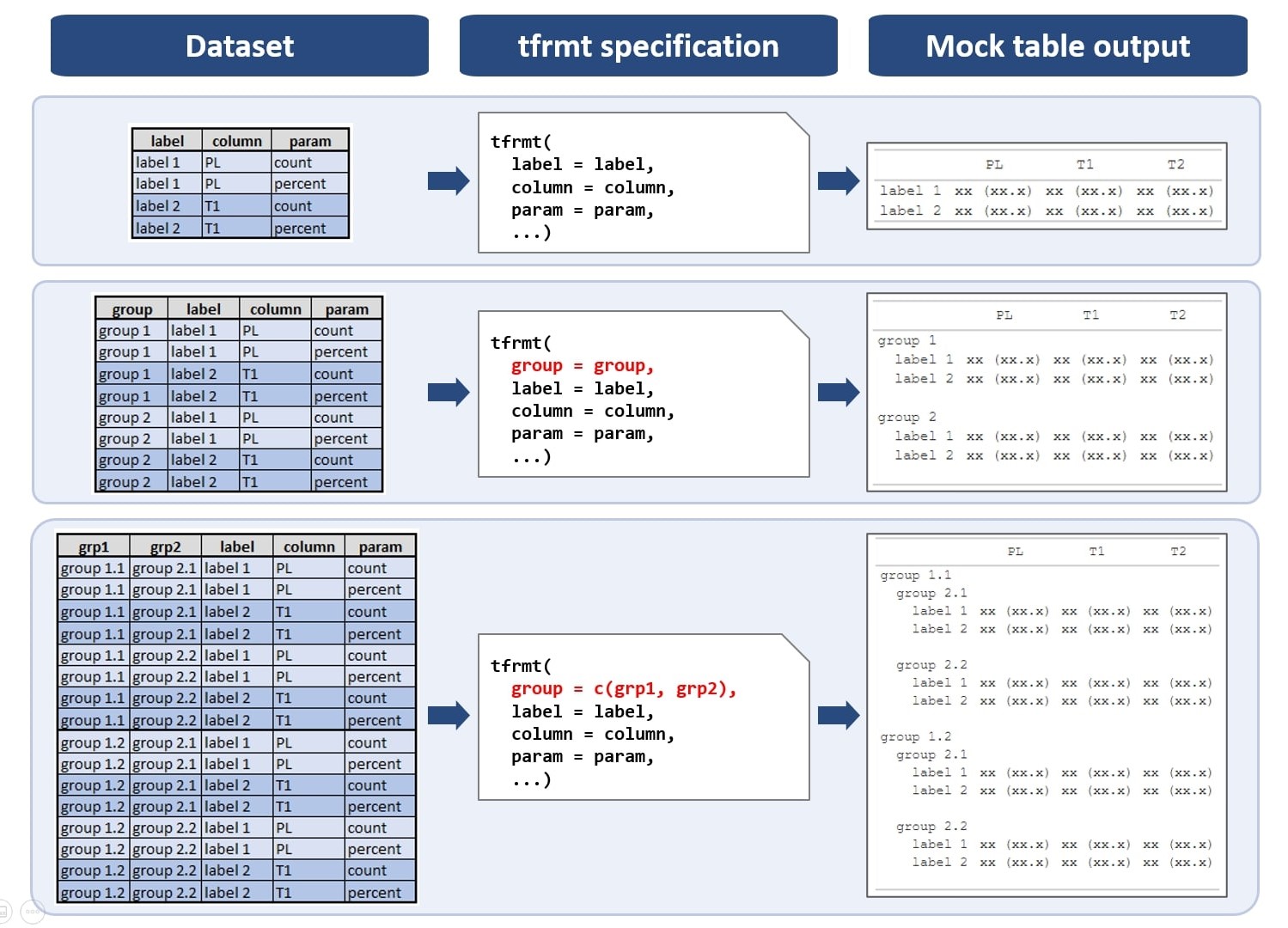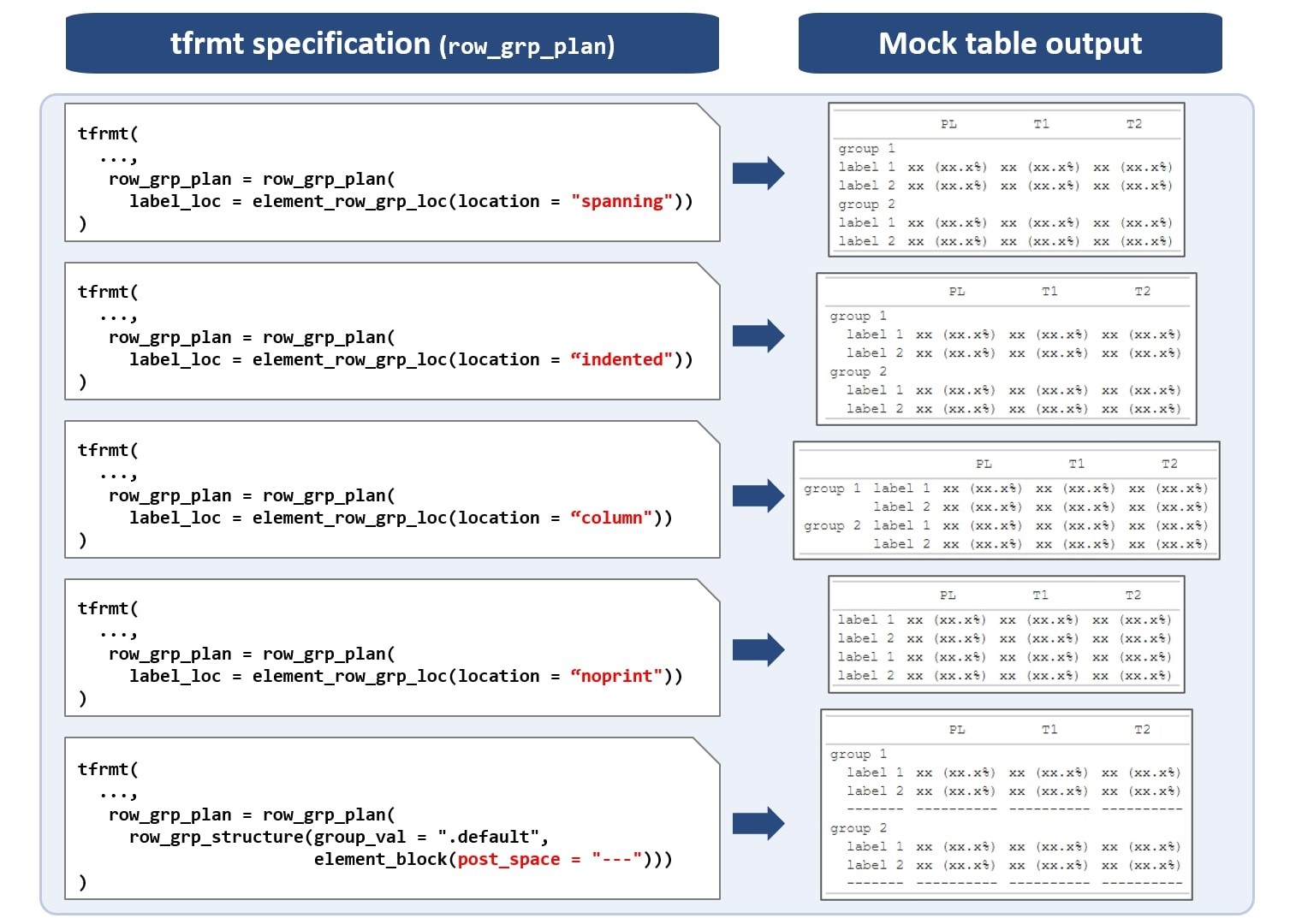Performing many calculations within a group is easier than ever due to tools in the tidyverse. tfrmt’s expectation of a standard, long data format is not only in alignment with tidy data principles and workflows, but it allows for the user to easily specify group-wise aesthetic formatting. tfrmt also allows the user to display row labels in a variety of ways.
Row group structure
Like the body_plan, tfrmt’s row group plan
(row_grp_plan), allows the user to specify any number of
row group structure (row_grp_structure) objects, which
define how groups of rows should appear.
The row_grp_structure contains group_val
argument to define the relevant group values; this behaves like a filter
to the relevant values. From there, the row_grp_structure
essentially performs a group_by to apply the formatting within each
unique combination of group values.
Element block objects
As the row_grp_structures are purely aesthetic in
nature, they accept element_block objects which define the
styling of a given group of rows. element_block objects are
a work in progress, but they currently provide the ability to add empty
rows or lines following groups of data.
To add a post space after all groups of values based on the variable
“grp1” (our group in the tfrmt object) we do the
following:
row_grp_structure(group_val = ".default", element_block(post_space = " "))
my_tfrmt <- tfrmt(
group = grp1,
label = label,
param = param,
value = value,
column = column,
row_grp_plan = row_grp_plan(
row_grp_structure(group_val = ".default", element_block(post_space = " "))
),
body_plan = body_plan(
frmt_structure(group_val = ".default", label_val = ".default", frmt("xx"))
)
)
print_mock_gt(my_tfrmt, .default = 1:2)%>%
tab_style(
style = cell_text(whitespace = "pre", align = "left"),
locations = cells_stub()
)| column1 | column2 | column3 | |
|---|---|---|---|
| grp1_1 | |||
| label_1 | xx | xx | xx |
| label_2 | xx | xx | xx |
| grp1_2 | |||
| label_1 | xx | xx | xx |
| label_2 | xx | xx | xx |
To add a post space after values where grp1 = “grp1_1” only we do the following:
my_tfrmt <- tfrmt(
group = grp1,
label = label,
param = param,
value = value,
column = column,
row_grp_plan = row_grp_plan(
row_grp_structure(group_val = "grp1_1", element_block(post_space = " "))
),
body_plan = body_plan(
frmt_structure(group_val = ".default", label_val = ".default", frmt("xx"))
)
)
print_mock_gt(my_tfrmt, .default = 1:2)%>%
tab_style(
style = cell_text(whitespace = "pre", align = "left"),
locations = cells_stub()
)| column1 | column2 | column3 | |
|---|---|---|---|
| grp1_1 | |||
| label_1 | xx | xx | xx |
| label_2 | xx | xx | xx |
| grp1_2 | |||
| label_1 | xx | xx | xx |
| label_2 | xx | xx | xx |
As group_val = "grp1_1" in this table rather than
group_val = "default" previously, the post space after
grp1_2 is removed.
Row labels
The gt package offers default displays for group and row labels which do not cover all use cases, particularly if the user provides more than one group variable. As such, tfrmt offers multiple objects for display. Let’s see how they differ for the following options:
- indented: Combined group/label variables
- spanning: Group label as row spanning header
- column: Group label in separate column
- noprint: Drop group labels
indented
tfrmt will combine group and label variables into a single column, using indentation to distinguish the hierarchies:
my_tfrmt <- tfrmt(
group = c(grp1, grp2),
label = label,
param = param,
value = value,
column = column,
row_grp_plan = row_grp_plan(label_loc = element_row_grp_loc(location = "indented")),
body_plan = body_plan(
frmt_structure(group_val = ".default", label_val = ".default", frmt("xx"))
)
)
print_mock_gt(my_tfrmt, .default = 1:2)%>%
tab_style(
style = cell_text(whitespace = "pre", align = "left"),
locations = cells_stub()
)| column1 | column2 | column3 | |
|---|---|---|---|
| grp1_1 | |||
| grp2_1 | |||
| label_1 | xx | xx | xx |
| label_2 | xx | xx | xx |
| grp2_2 | |||
| label_1 | xx | xx | xx |
| label_2 | xx | xx | xx |
| grp1_2 | |||
| grp2_1 | |||
| label_1 | xx | xx | xx |
| label_2 | xx | xx | xx |
| grp2_2 | |||
| label_1 | xx | xx | xx |
| label_2 | xx | xx | xx |
spanning
This is the default option from gt: group labels become spanning headers over the rows. Note that in the case of multiple group variables, only the top level group variable will be in the spanning row header, and the rest will combine with the label variable using indentation:
my_tfrmt <- tfrmt(
group = c(grp1, grp2),
label = label,
param = param,
value = value,
column = column,
row_grp_plan = row_grp_plan(label_loc = element_row_grp_loc(location = "spanning")),
body_plan = body_plan(
frmt_structure(group_val = ".default", label_val = ".default", frmt("xx"))
)
)
print_mock_gt(my_tfrmt, .default = 1:2)%>%
tab_style(
style = cell_text(whitespace = "pre", align = "left"),
locations = cells_stub()
)| column1 | column2 | column3 | |
|---|---|---|---|
| grp1_1 | |||
| grp2_1 | |||
| label_1 | xx | xx | xx |
| label_2 | xx | xx | xx |
| grp2_2 | |||
| label_1 | xx | xx | xx |
| label_2 | xx | xx | xx |
| grp1_2 | |||
| grp2_1 | |||
| label_1 | xx | xx | xx |
| label_2 | xx | xx | xx |
| grp2_2 | |||
| label_1 | xx | xx | xx |
| label_2 | xx | xx | xx |
column
In this case, group labels become a separate column to the left. Note that in the case of multiple group variables, only the top level group variable will be in the column, and the rest will combine with the label variable using indentation:
my_tfrmt <- tfrmt(
group = c(grp1, grp2),
label = label,
param = param,
value = value,
column = column,
row_grp_plan = row_grp_plan(label_loc = element_row_grp_loc(location = "column")),
body_plan = body_plan(
frmt_structure(group_val = ".default", label_val = ".default", frmt("xx"))
)
)
print_mock_gt(my_tfrmt, .default = 1:2)%>%
tab_style(
style = cell_text(whitespace = "pre", align = "left"),
locations = cells_stub()
)| column1 | column2 | column3 | ||
|---|---|---|---|---|
| grp1_1 | grp2_1 | |||
| label_1 | xx | xx | xx | |
| label_2 | xx | xx | xx | |
| grp2_2 | ||||
| label_1 | xx | xx | xx | |
| label_2 | xx | xx | xx | |
| grp1_2 | grp2_1 | |||
| label_1 | xx | xx | xx | |
| label_2 | xx | xx | xx | |
| grp2_2 | ||||
| label_1 | xx | xx | xx | |
| label_2 | xx | xx | xx | |
noprint
A user may also suppress the printing of any group variable by specifying the “noprint” option.
my_tfrmt <- tfrmt(
group = c(grp1, grp2),
label = label,
param = param,
value = value,
column = column,
row_grp_plan = row_grp_plan(label_loc = element_row_grp_loc(location = "noprint")),
body_plan = body_plan(
frmt_structure(group_val = ".default", label_val = ".default", frmt("xx"))
)
)
print_mock_gt(my_tfrmt, .default = 1:2)| column1 | column2 | column3 | |
|---|---|---|---|
| label_1 | xx | xx | xx |
| label_2 | xx | xx | xx |
| label_1 | xx | xx | xx |
| label_2 | xx | xx | xx |
| label_1 | xx | xx | xx |
| label_2 | xx | xx | xx |
| label_1 | xx | xx | xx |
| label_2 | xx | xx | xx |

